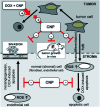Cerium oxide nanoparticles: properties, biosynthesis and biomedical application
- PMID: 35515804
- PMCID: PMC9055511
- DOI: 10.1039/d0ra04736h
Cerium oxide nanoparticles: properties, biosynthesis and biomedical application
Abstract
Nanotechnology is the branch of science which deals with particles ranging between 1-100 nm. These particles are called nanoparticles, and they exhibit unique electronic, optical, magnetic, and mechanical properties, which make them different from the bulk material. These properties of nanomaterials help them to find a variety of applications in the biomedical, agricultural, and environmental domains. Cerium oxide nanoparticles have gained a lot of attention as a potential future candidate for ending various kinds of problems by exhibiting redox activity, free radical scavenging property, biofilm inhibition, etc. Synthesis of these nanoparticles can be performed very easily by utilizing chemical or biological methods. But in this review, the focus is laid on the biosynthesis of these nanoparticles; as the biosynthesis method makes the cerium oxide nanoparticle less toxic and compatible with the living tissues, which helps them to find their path as an anticancer, anti-inflammatory and antibacterial agents. The pre-existing reviews have only focused on details relating to properties/applications/synthesis; whereas this review draws attention towards all the aspects in single review covering all the details in depth such as biosynthesis methods and its effect on the living tissues, along with properties, biomedical applications (diagnostic and therapeutic) and future outlook of the cerium oxide nanoparticle.
This journal is © The Royal Society of Chemistry.
Conflict of interest statement
Author's declare no conflict of interest for this work.
Figures
















Similar articles
-
Cerium oxide nanostructures: properties, biomedical applications and surface coatings.3 Biotech. 2022 May;12(5):121. doi: 10.1007/s13205-022-03186-3. Epub 2022 Apr 23. 3 Biotech. 2022. PMID: 35547014 Free PMC article. Review.
-
Role of Cerium Oxide Nanoparticles and Doxorubicin in Improving Cancer Management: A Mini Review.Curr Pharm Des. 2023;29(33):2640-2654. doi: 10.2174/0113816128270290231029161741. Curr Pharm Des. 2023. PMID: 37957864 Review.
-
Redox Active Cerium Oxide Nanoparticles: Current Status and Burning Issues.Small. 2021 Dec;17(51):e2102342. doi: 10.1002/smll.202102342. Epub 2021 Aug 6. Small. 2021. PMID: 34363314 Review.
-
Structural and functional insights in polysaccharides coated cerium oxide nanoparticles and their potential biomedical applications: A review.Int J Biol Macromol. 2023 Aug 15;246:125673. doi: 10.1016/j.ijbiomac.2023.125673. Epub 2023 Jul 3. Int J Biol Macromol. 2023. PMID: 37406905 Review.
-
The Use of Cerium Compounds as Antimicrobials for Biomedical Applications.Molecules. 2022 Apr 21;27(9):2678. doi: 10.3390/molecules27092678. Molecules. 2022. PMID: 35566026 Free PMC article. Review.
Cited by
-
The Synthesis, Characterization, and Assessment of Antibacterial Properties of an Orthodontic Adhesive Containing Cerium-Substituted Hydroxyapatite Nanoparticles: An In Vitro Study.Cureus. 2024 Jan 12;16(1):e52177. doi: 10.7759/cureus.52177. eCollection 2024 Jan. Cureus. 2024. PMID: 38344531 Free PMC article.
-
Polyethylene glycol-derived polyelectrolyte-protein nanoclusters for protein drug delivery.RSC Adv. 2021 Aug 25;11(46):28651-28658. doi: 10.1039/d1ra05055a. eCollection 2021 Aug 23. RSC Adv. 2021. PMID: 35478532 Free PMC article.
-
Sol-gel synthesis and cytotoxicity evaluation of selenium-doped cerium oxide nanoparticles for biomedical applications.Naunyn Schmiedebergs Arch Pharmacol. 2024 May;397(5):3437-3447. doi: 10.1007/s00210-023-02823-9. Epub 2023 Nov 14. Naunyn Schmiedebergs Arch Pharmacol. 2024. PMID: 37962586
-
Regulating the microenvironment with nanomaterials: Potential strategies to ameliorate COVID-19.Acta Pharm Sin B. 2023 Feb 21;13(9):3638-58. doi: 10.1016/j.apsb.2023.02.010. Online ahead of print. Acta Pharm Sin B. 2023. PMID: 36846153 Free PMC article. Review.
-
CeO2-Azacrown Conjugate as a Nanoplatform for Combined Radiopharmaceuticals.Nanomaterials (Basel). 2022 Dec 18;12(24):4484. doi: 10.3390/nano12244484. Nanomaterials (Basel). 2022. PMID: 36558337 Free PMC article.
References
-
- Singh R. P. Oh B. K. Koo K. K. Jyoung J. Y. Jeong S. Choi J. W. BioChip J. 2009;2:223–234.
-
- Singh R. P. J. Bioanal. Biomed. 2016;8:e143. doi: 10.4172/1948-593x.1000e143. - DOI
Publication types
LinkOut - more resources
Full Text Sources

